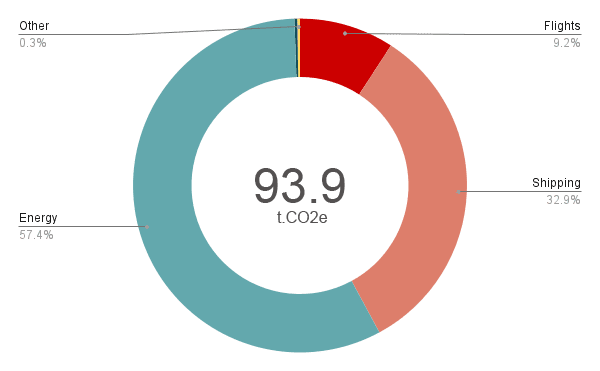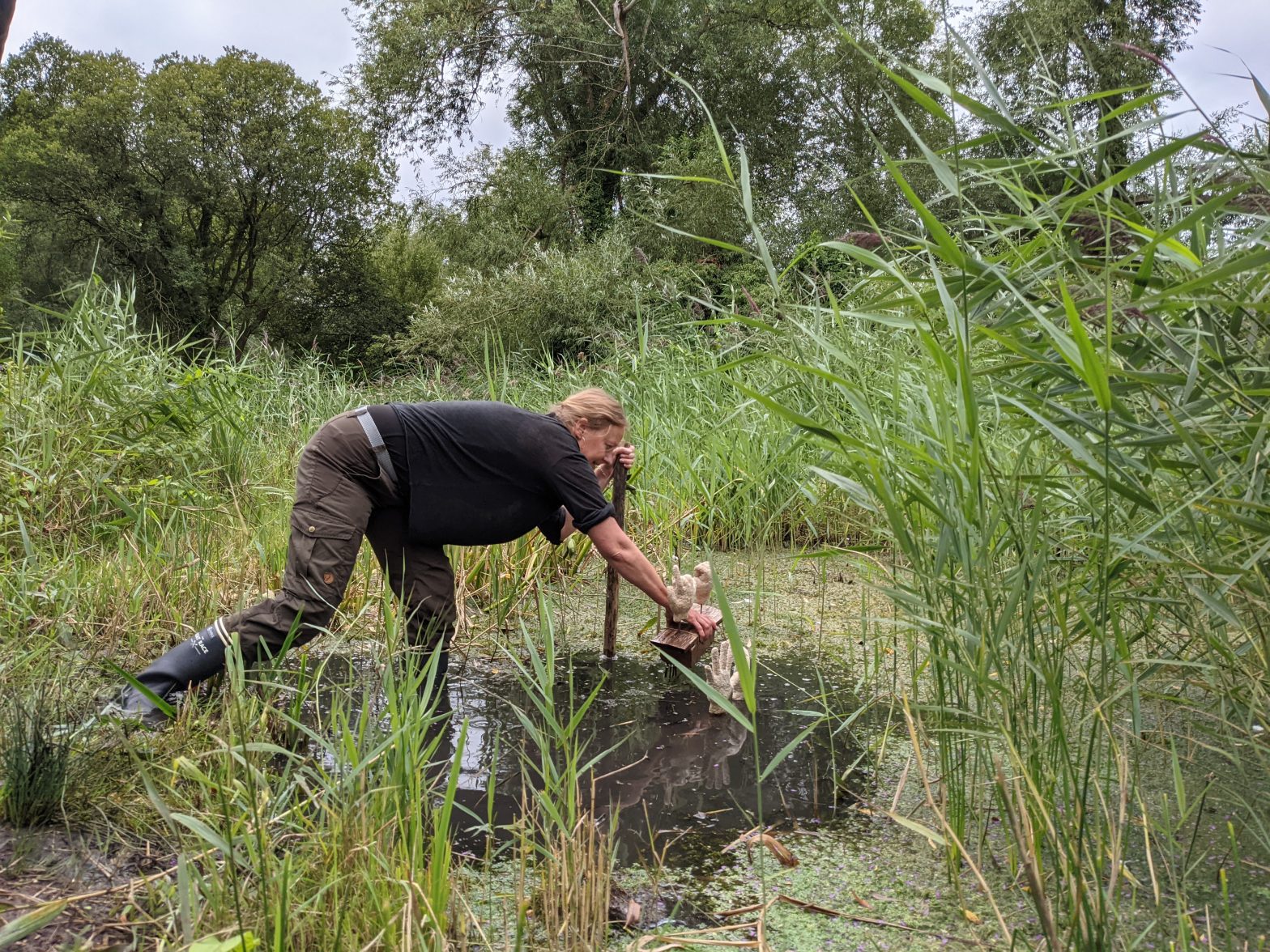Modern Art Oxford recognises the urgency and the gravity of the environmental emergency and is committed to taking the fullest action to mitigate its impact on the environment.
Operating in safe, ethical and environmentally responsible approaches across the organisation is vital to who we are as an organisation. This statement holds us accountable to complying with, and where possible exceeding, environmental legislation which reduces the negative environmental impacts of our organisation in energy use, water use, waste, travel and resources. We are in the process of better understanding our carbon emissions, through responding to Julie’s Bicycle best practice and reporting our carbon emissions to them annually. From this we know, the biggest source of carbon emissions at Modern Art Oxford comes from energy consumption in the building. Heating is delivered by gas fuelled heating services that are over 30 years old, within a converted former Victorian brewery building.

The exhibitions programme involves the display of work by international artists. Therefore, carbon emissions are generated through shipping and freight. Wherever possible, we borrow from UK and European lenders, combine shipping journeys and avoid air freight. Some exhibitions require new temporary walls to be built. We source sustainable materials and reuse and recycle construction materials in-house. Built structures are deconstructed and reused or offered to local organisations rather than sent to landfill.
What We Have Done
- Carbon Literacy training provided for the majority of Modern Art Oxford staff.
- A Small Capital project was completed in November 2018 to carry out essential maintenance and replace old plant and services in the office tower with new more efficient equipment, replaced windows with new double glazing and a new passenger lift.
- A small building project was completed in 2021 to refurbish the visitor toilets and improve lighting in the ground floor and Basement areas to reduce consumption of electricity and water. Replacing lighting throughout with energy efficient LEDs, motion controlled lighting in areas used intermittently and we have installed smart meters to help us better track and report on our energy usage.
- We promote cycling, walking and public transport as the best ways to travel to the gallery for staff, volunteers and visitors.
- An employee cycle to work scheme was introduced in 2019 and updated in 2023 to make it more accessible to colleagues.
- We introduced sustainability statements for all areas of activity from 2023/24.
Our objectives in relation to Environmental Action are as follows:
- To reduce carbon emissions and landfill annually by 5% each totalling a 20% reduction by the end of the 2026/27 FY.
- To be carbon neutral by 2040, in line with Oxford City Council’s environmental charter.
- To use the opportunities arising from our content creation and programming to raise awareness of environmental concerns and encourage action.
- Continue to encourage zero and low carbon forms of transport for staff and visitors.
- Ensuring the majority of our international shipping is carried out by sea, rail or road rather than air by 2028.
- Ensuring all of our packing materials are reusable or curbside recyclable by 2026, as a step towards zero-waste operations by 2040.
- Audit building energy efficiency within 2024 ground floor refurbishment project, reducing energy use through replacement of heating services.
- To learn from and share best practice with other galleries and local businesses.
- To strengthen our evaluation and analysis methods to better understand and communicate the impact of our Environmental Action Plan.
- To be an active member of the Green Arts Charter for Oxford and the Galleries Climate Coalition, and to work with Julie’s Bicycle on the Creative Green Programme, playing a leading role where possible.
- To communicate our environmental targets and practices to all stakeholders including staff, visitors and suppliers.
Modern Art Oxford will deliver these through its Sustainability Action Plan each year, which is embedded in its procurement and working processes, reviewed annually and monitored on an ongoing basis by the Environmental Working Group.
Departmental sustainability objectives
Operations and Facilities
- Increase recycling by 20% and reduce landfill by 20% by March 2026
- Reduce in-house material printed internally by 50% by March 2026
- Reduce energy consumption by 5% each year 2023-2026
Digital and Communications
- Measure, track and reduce the carbon emissions of our website by March 2026
- Measure, track and reduce the carbon emissions we are creating via our use of social media by March 2026
- Share our progress via an annual environmental responsibility statement
- Regularly amplify diverse voices calling for climate justice and share best practice on our channels
Development
- Use environmental audit (October 2023) to identify funding opportunities
- Audit our funders, including corporate partners, to ensure shared priorities around environmental sustainability and mutual learning and relationship development where possible
- Encourage national supporter trips and short haul destinations reached by rail
- Continuously make environmentally conscious amendments to our work
Exhibitions
- Audit recent exhibitions from 2022 onwards to establish a CO2e baseline
- Compile a database of materials and their CO2e to inform exhibition design and planning and make sustainable choices
- Make informed curatorial decisions about loaning artworks from international collections and seek to secure UK or EU based loans where possible.
- Carry out curatorial research using train travel where possible
- Create a carbon budget for the 2025 onwards exhibitions programme, informed by the established CO2e baseline from previous exhibitions and maintain a reduction in CO2e going forward
- Set realistic goals to reduce CO2e from exhibition production
- Reduce virgin/single use plastics in artwork packing
Commercial
- Achieve 70% Oxfordshire produced items in the Cafe by March 2025, particularly focussing on locally produced drinks and meat items
- Reduce Food waste and increase recycling by 50% in Cafe by March 2024
- Eliminate all waste in Cafe through the Reduce, Reuse, Recycle process by March 2025
- Remove all use of single use plastics from all areas and find alternative solutions by March 2025
- Reduce energy consumption in cafe and kitchen by 5% each year 2023-2026
- Achieve 90% UK produced items in Retail by March 2025 with a priority for Oxford-based suppliers
- Reducing surplus stock in retail by 50% by December 2024
- Eliminate all waste in Retail through the Reduce, Reuse, Recycle process by March 2025
- Remove all use of single use plastics from all areas and find alternative solutions by March 2025
Communities, Participation and Practice
- Ensure that wherever possible workshop materials are bought from sustainable suppliers
- Stop using Amazon where possible
- Shop locally to avoid unnecessary and excessive deliveries
- The team will regularly schedule conversations around materials usage, to make sure materials are re-used and shared between projects, to avoid wastage
- Ensure that issues around sustainability and our environmental impact are engaged with and reflected on regularly with the groups we work with
- Ensure that workshop participants are aware of any reused or repurposed materials used within sessions or project builds, in order to make carbon awareness part of our everyday conversations about material choices and artwork production
- Use natural paints, dyes etc in workshops where possible
- Continue to seek guidance and advice from the international community of arts organisations working with the Gallery Climate Coalition (GCC) to reduce the environmental impact of our exhibitions programme
